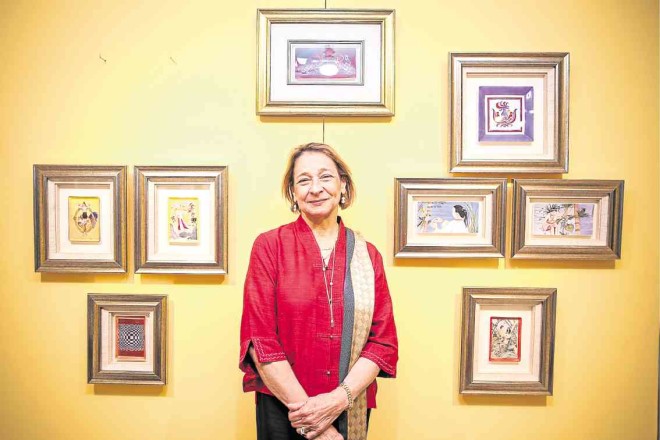
Sometimes, things have a strange way of coming together.
Consider the story of Portuguese painter Arlinda Frota, who’s also an intensive care doctor and diplomatic spouse.
Childhood memories include Portuguese gardens filled with butterflies, peonies and roses. Her mother, Martinha Chaves—a math and physics teacher who likewise played the piano—was “a good collector of porcelains and teapots.” She also painted on canvas and silk cushions.
Husband Carlos is a diplomat.
One day, while Frota, a mother of four, was resting after a grueling day’s work in the hospital, Carlos arrived with “bags of acrylic colors.” The message was not exactly subtle. He wanted his wife to pick up a brush and learn to paint.
Frota was amused but wondered when she would have the time. “I work a lot because my discipline was intensive care,” she explained.
“Don’t worry, you will make it one day,” Carlos assured her.
His diplomatic career took the family to different countries—Indonesia one day, South Korea the next. It was during Carlos’ stint in Macau when Frota met her mentor, a patient and fellow Portuguese with a turbulent domestic life.
During one confinement, the patient vowed, before her illness worsened, to teach her doctor to paint on ceramic.
It took a while before Frota took up the brush. After all, her patient Natalia should be the first to understand that her working hours were intense. Natalia was insistent, however. “I feel you are the right person to become a painter,” she told Frota.
As Natalia’s health deteriorated, Frota eventually felt the need to learn the skill. Natalia is now gone.
Frota has moved forward, picking up what’s left of Carlos’ big bag of acrylics before flying with him to Indonesia to learn batik painting, and to South Korea for classic rice paper painting lessons.
Delicacy
“The delicacy of the traditional arts, the minutiae of details when painting flowers, trees, landscapes, birds, plants, butterflies, bees and other subjects drawn from nature or human figures, have enchanted me since childhood,” Frota said.
Themes inspired by the countries she has visited are evident in her chosen medium, calling porcelain a means to “bring into physical form feelings and harmony that give meaning to the universe, society, nature and humanity.”
Porcelain itself is a delightful material, she noted. “Even the touch… the brightness and light it emanates are complimentary reasons for my devotion,” the painter explained.
Frota has exhibited around the world. One of her works was presented to a recipient of the Kofi Anan Prize at the 7th World Peace Exhibition that the former United Nations secretary-general himself handed over.
Does Frota realize how things from her experiences came together—how her mother’s teapots, Portugal’s flowers and butterflies, Carlos’ acrylics, and Natalia’s friendship have all brought her where she is now?
“People ask me how I started and I wonder if I should share these reasons,” she said. “This is a very strong story for me. I love this art, I love what I can do. I feel I can do wonderful things. I create stories for people all over the world. I feel happy.”
Frota said she believes Natalia continues to guide her “many times.”
100th Fatima anniversary
For the special “Portugal Divino!” festival currently being held at Rustan’s Makati, Frota made porcelain pieces that depict Filipino mythological characters such as Malakas and Maganda, as well as artisan weavers of banana and piña fabrics.
She’s particularly proud of a large plate on which she painted a butterfly donning the national flag’s colors, with Bohol’s Chocolate Hills in the background.
A special collection of plates features Our Mother of Perpetual Help, Our Lady of Fatima and other images of the Virgin Mary, aside from Frota’s favorite flowers, batik patterns and butterflies lovingly rendered on porcelain cups and plates.
Frota’s works will be on display until May 25, fifth floor, Rustan’s Makati, then to Rustan’s Shangri-La Plaza from May 26 to June 6.
Other pieces on display are ceramic serveware from Bordallo Pinheiro, contemporary porcelain dinnerware and glassware from Casa Alegre, classic cookware of Silampos, flatware from Herdmar and table linens from Texteis.
An exhibit honoring the 100th anniversary of Our Lady of Fatima’s apparitions is ongoing on the fifth floor of Rustan’s Makati until June 6.